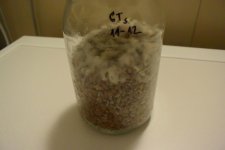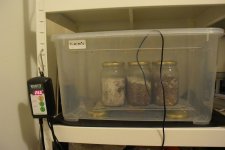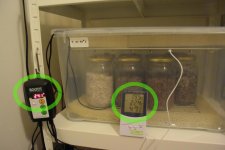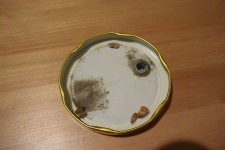blue.magic
Rising Star
I have inoculated several 900 ml rye jars.
Unfortunately, the colonization seems to have stopped in all the jars.
The first picture is the jar inoculated from agar slurry on Nov 11. There are patches of uncolonized rye and it looks the same for the last 10 days.
The second picture is the jar inoc. from liquid culture on Nov 25. I have shaken the jar a week ago to make new inoc. sites but there are few colonized patches and nothing changed.
The third jar is inoculated from spore solution on Nov 12, not shaken. Only the top part got colonized and the rye seems completely dry.
Is there anything I can do to salvage these jars? What could have possibly gone wrong? Has it dried out? The incubator is a clear plastic box (closed with several 6 mm holes on top and bottom of front and back walls) with heating pad below keeping the temperature around 26-27 C (79-80 F) all the time.
There are no signs of contamination, just while fluffy mycelium with occassional rhizomorphic growth. I guess if there were contams, it would have been already colonized by molds.
The rye has been soaked with a bit of gypsum for 12 hours (it started germinating very quickly so I avoided longer soaks). Then boiled for 15 minutes, then strained and dried by shaking the collander for approx. 15 minutes, then loaded in jars and sterilized at 15 psi for 90 minutes, cooled overnigh inside PC and inoculated the next day.
I am not sure about the cooking times - some say to cook the rye for 10 minutes, others say 60 minutes. Same with sterilization - some say 20 minutes are OK but others say 90 minutes...
Unfortunately, the colonization seems to have stopped in all the jars.
The first picture is the jar inoculated from agar slurry on Nov 11. There are patches of uncolonized rye and it looks the same for the last 10 days.
The second picture is the jar inoc. from liquid culture on Nov 25. I have shaken the jar a week ago to make new inoc. sites but there are few colonized patches and nothing changed.
The third jar is inoculated from spore solution on Nov 12, not shaken. Only the top part got colonized and the rye seems completely dry.
Is there anything I can do to salvage these jars? What could have possibly gone wrong? Has it dried out? The incubator is a clear plastic box (closed with several 6 mm holes on top and bottom of front and back walls) with heating pad below keeping the temperature around 26-27 C (79-80 F) all the time.
There are no signs of contamination, just while fluffy mycelium with occassional rhizomorphic growth. I guess if there were contams, it would have been already colonized by molds.
The rye has been soaked with a bit of gypsum for 12 hours (it started germinating very quickly so I avoided longer soaks). Then boiled for 15 minutes, then strained and dried by shaking the collander for approx. 15 minutes, then loaded in jars and sterilized at 15 psi for 90 minutes, cooled overnigh inside PC and inoculated the next day.
I am not sure about the cooking times - some say to cook the rye for 10 minutes, others say 60 minutes. Same with sterilization - some say 20 minutes are OK but others say 90 minutes...






 There's a difference between poking ye needle holes and fine puncturing the micropore tape with a thin needle... yet again, tried and tested method, airborne proof :thumb_up:
There's a difference between poking ye needle holes and fine puncturing the micropore tape with a thin needle... yet again, tried and tested method, airborne proof :thumb_up: